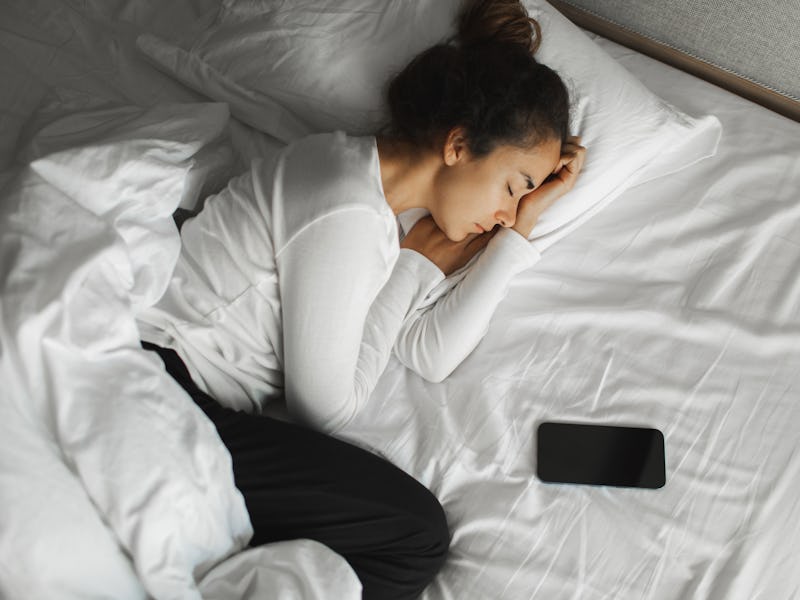These 3 Sleep Science “Hacks” Can Help Cure Your Insomnia
Two sleep experts reveal what it really takes to get a good night’s rest.

For millennia, living creatures have engaged in the sacred art of sleep, but it still remains one of the most evasive necessities for some. Sleep can be hard to come by, but an ideal sleep environment shouldn’t be out of reach for everyone.
Rafael Pelayo, a sleep psychiatry professor at Stanford University, and Meredith Broderick, a sleep neurologist at Overlake Hospital Medical Center in Washington and a member of the medical advisory board for sleep solutions company Ozlo Sleep, describe what makes for the perfect sleep environment, and the science behind why they work.
Keep your bedroom dark and cool
Temperature and light are two of the most influential factors, Broderick wrote in an email to Inverse. You probably know that friend who keeps their bedroom at tundra-type temperatures and can’t sleep if it’s a degree warmer than freezing. There’s some sense to that because it’s an adaptive mechanism. Once the sun goes down, outdoor temperatures drop dramatically. To adapt, humans also modified their internal temperature.
“Our bodies shift our blood distribution to the core and away from the limbs to conserve heat,” she writes. “That drops our body temperature.” The magic number for ambient temperature is about 65 degrees Fahrenheit, Broderick writes.
As for light, our bodies follow an internal clock that takes cues from natural light and dark cycles. Exposure to light and dark when we’re not used to seeing them can cross your circadian rhythm’s signals.
Wind down two hours before bedtime
Our inner state is just as important as the state of our surroundings, Pelayo emphasizes. Our choices throughout the day affect how we sleep at night, so he recommends paying attention to both how much caffeine you are consuming and any naps you are taking, both of which can make sleep harder to come by at night.
He says a crucial part of sleeping that tends to get overlooked is actual drowsiness.
“It's amazing how many people go to sleep without feeling sleepy,” he tells Inverse. They might go to sleep, rather, just because they feel they’re supposed to. The two hours before bedtime are prime for creating those ideal sleep environments, which tell your brain and body sleep is nigh.
Don’t be alarmed if you notice a jolt of energy during that time, which Pelayo attributes to a surge from a cluster of neurons in the hypothalamus. This cluster, called the super charismatic nucleus, is the “master pacemaker” of our circadian rhythm. It may seem counterintuitive, but he speculates humans evolved this hyper state before bedtime in order to suss out any predators ahead of snoozing. Sleeping, he acknowledges, is a creature’s most vulnerable state.
“You can only go to sleep if you have a nice, safe place to sleep,” he says. You may have spent the night in questionable environments and still gotten some shut-eye, but Pelayo says that typically the best sleep you get is in your own bed.
Separate your workspace from sleep area
Of course, sleeping in your own bed doesn’t guarantee good rest. The mind and body must be relaxed enough to drift off. Prepping our brains for sleep can go a long way for relaxation. A part of this prep is moving to a distinct location, one that’s separate from where we rest. Broderick emphasizes the importance of separating your work and recreation spaces from your rest space.
Broderick says that these cues can be trained. She writes that a consistent sleep ritual can be as simple as washing your face and brushing your teeth. Some other practices may further promote drowsiness, like taking a hot bath before bed. Pelayo explains that heat makes us sleepy because it makes our blood vessels widen to ventilate excess warmth. Once you’re out of a hot tub, your body will cool down faster because it’s already getting rid of heat.
“The brain is processing every aspect of the environment as we get ready for bed,” Broderick writes. “But in general, typical sleep cues are an environment that is quiet, cool, dark, and safe.”
This article was originally published on